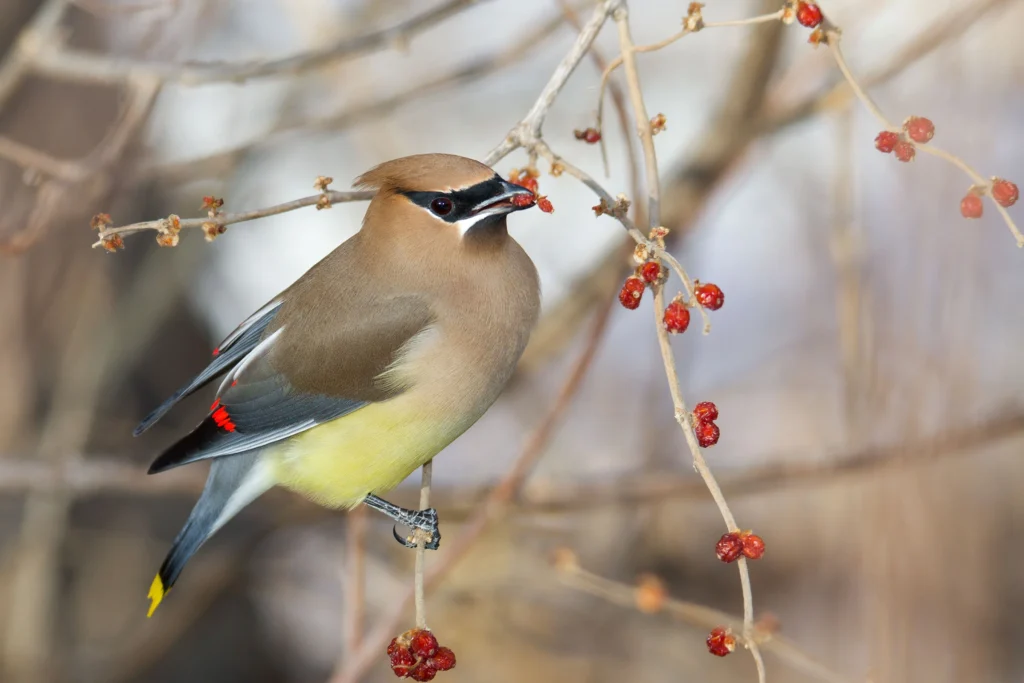Unlocking the Enigma: Navigating the Intricate World of Bohemian and Cedar Waxwings as They Dance Through Winter’s Chill
When you hear a chorus of high-pitched see! notes overhead, expect a good time: A rambunctious flock of waxwings is on its way. Highly social birds that appear to have no sense of personal space, North America’s two waxwing species—Bohemian and Cedar—also look very similar. Telling these elegant birds apart makes for an excellent ID challenge.
During the breeding season, location can provide an initial gut check. Cedar Waxwings are predominant throughout the northern continental United States and southern Canada, inhabiting open areas or forest edges. Bohemian Waxwings are found mostly in boreal forests and muskeg in Alaska and western Canada, with some records in the northwestern United States, too.
But the species overlap in parts of their ranges, and that common ground grows during the winter, when both rove far and wide in search of food. Because of their fruit-heavy diet, you’re not likely to find either species at a bird feeder, but you might encounter them at any fruiting tree in their range, even ornamental trees in yards and parking lots.
During the winter months, Cedar Waxwings range further south than Bohemians on average, showing up throughout southern Canada, the continental United States, Mexico, and sometimes Central America. While Bohemian Waxwings are generally scarce and irregular south of the Canadian border, they can become locally numerous in the northern Rocky Mountains east to northern Minnesota. In years when food is scarce, they may wander southward along the Rockies or into the Midwest, New York, New England, and rarely even further south. These southward-straying Bohemians sometimes join up with flocks of the more common Cedars.
When you come across a flock with both species, size might be the most obvious differentiator. Cedar Waxwings are smaller, similar in size to a large sparrow. Bohemians are nearly an inch longer and twice as heavy; in flight, they may give the impression of a European Starling. However, size can also deceive. A Cedar Waxwing may look larger when flying solo or when fluffed up against the cold.
Certain plumage characteristics offer diagnostic identification points, too. Bohemians take on a cooler gray tone overall with a red-orange face, while Cedars appear sandy or tan. Bohemians also have more intricate patterning on their wings, with more white marks and a yellow streak running down their primary wing feathers. Finally, and perhaps most tellingly, Bohemians have rust-colored undertail coverts—the feathers that meet the tail on the bird’s underside—while Cedars’ undertail coverts are white.

The genders appear alike in both species, but male Cedar and Bohemian Waxwings typically exhibit more extensive black in their chins compared to females. Additionally, males boast larger waxy red tips—yes, a genuine waxy secretion—on their feathers than females, on average. It’s worth noting that both characteristics can be challenging to discern in the field. Meanwhile, juvenile birds of both species display grayer and streakier plumage, only acquiring their distinctive wingtips as they mature. The exact purpose of these wax wings remains unclear, but given that older birds tend to have more of them, it’s plausible that they serve as signals for the health, age, and social status of birds within the flock.
Although the two birds emit similar and occasionally identical sounds, with practice, one can typically differentiate them by their vocalizations. Cedar Waxwings produce extremely high-pitched whistles and trills, resembling insect-like sounds. In contrast, Bohemian Waxwings generally emit a more guttural rattling trill, akin to a wet metal whistle.
As winter approaches and migratory birds embark on their journey south, the potential for encountering waxwings becomes a source of excitement and motivation to venture out for birdwatching in the cold. Hopefully, this winter will reward you with opportunities to observe and study both waxwing species, relishing in their playful behaviors and gaining a deeper appreciation for these charming birds.

Just wish to say your article is as surprising. The clearness in your post is just cool and i could assume you’re an expert on this subject. Fine with your permission allow me to grab your RSS feed to keep updated with forthcoming post. Thanks a million and please keep up the enjoyable work.